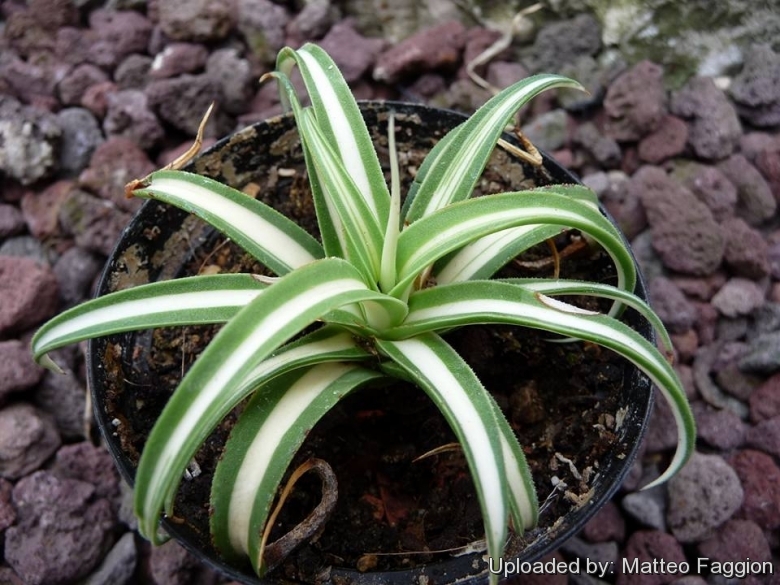
Agave bracteosa f. mediopicta alba Photo by: Matteo Faggion
Origin and Habitat: Garden origin. Agave bracteosa f. mediopicta albaSN|315]]SN|33018]] is a variegated cultivars discovered at Jardin Exotique de Monaco. The natural species (Agave bracteosaSN|33018]]SN|315]]) is native to northeastern Mexico, where it occurs in steep rocky areas and on cliffs in the mountains near Monterrey, Nuevo Leon and Saltillo, Coahuila.
Synonyms:
See all synonyms of Agave bracteosa
Common Names include:
ENGLISH: White-striped Agave, White-striped century plant, Variegated Octopus agave, Variegated Squid Agave, Frosted Candelabrum Agave, Perennial Century Plant, Spider Agave,
Description: Agave bracteosaSN|315]]SN|315]], also known "spider agave" or "squid agave", is a solitary or clumping agave that rarely exceeds 30-45 cm of height and 45-60 cm in diameter, individual rosettes have a graceful urn-like shape formed by a relatively few upright leaves leaves that grow up and curve out and down.
Agave bracteosaSN|315]]SN|315]] f. mediopicta: (a.k.a. 'Medio-picta', or 'Variegata') This form with heavily variegated leaves is very attractive and highly prized. It can be distinguished by the green leaf borders and cream variegation in the centre. Other names are "trade names". Often there are sports or mutations or seedlings.
Notes: Remarks: The Agave bracteosaSN|315]]SN|315]] does not always die after blooming, contrarily to most other Agaves. There has been some controversy to whether this species is always monocarpic, but most of the plants with mature flowers will dye, so it appears to be at least 'mostly' monocarpic.
Cultivation and Propagation: Agave bracteosa f. mediopicta is an exellent choice for growing in a container. Remains small and grows slowly, very slowly offsetting and forming a large colony of plants. A very elegant plant, this variegate deserves a special place in a semi-shady area of the rock garden, xeric garden, or even as an accent plant in the Mediterranean or tropical landscape.
Soil: As with most of the species, this one is not very particular about the type of soil it is in as long as it has good drainage.
Hardiness: It can tolerate extremes of both cold (Hardy to -8?C) and scorching heat.
Exposure: The variegated form can thrive in in half-sun, filtered-sun or deep shade and is more moisture tolerant than most agave; but, the soil must be well drained. It grows particularly well under the shade of small trees.
Water requirements: It is drought tolerant although they will respond to supplemental water and is more moisture tolerant than most agave.
Landscape value: This agave looks great as a potted plant, and can be placed on patios, near entryways, or in other spots where the plant would be highly visible. In the ground, use this beauty under the shade of small desert trees, mix into cactus and succulent gardens.
Propagation: Suckers (This Agave offsets freely and the pups can be removed and repotted or planted elsewhere) Keep a few however, for the main plant dies when it sends up its spectacular spike of flowers. Individual specimens are particularly beautiful.










